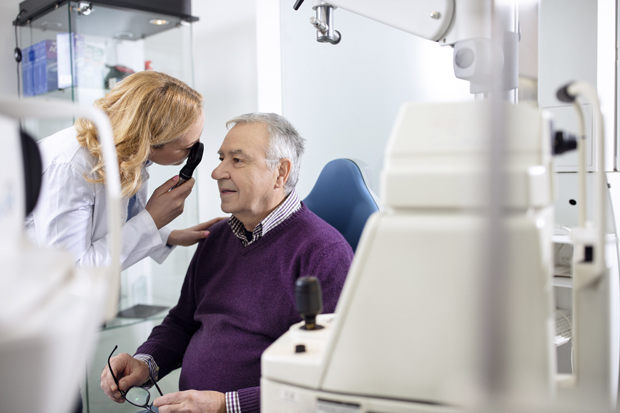
By Roger C. Croland, OD
You should have seen your eye doctor around age three and again as you were entering school. If you needed glasses, then you would have come back at least once every two years. Those who don’t need glasses many times forgo visiting their eye doctor unless they have a problem. By age 40, you should have a comprehensive baseline eye exam. This eye exam helps identify signs of eye disease at an early stage when treatments can have the biggest impact on preserving your vision later in life. You should continue to see your eye doctor every two years, unless otherwise suggested by your doctor. At age 65, you need to start making your appointment every year because progression of vision loss can occur more rapidly. Research has found that the eye’s cells responsible for the visual functions are more likely to degrade with age than the cells that are responsible for visual acuity and color vision. Environmental factors such as nutrition, smoking, and excessive sun exposure have been connected to age-related macular degeneration.
For many people, the beginning signs of growing older are the inability to focus on close objects after age 40, difficulty adjusting focus when switching from near to distance vision, and eye fatigue along with headaches when doing close work. This phenomenon is called presbyopia. Scientifically, presbyopia is a vision condition in which the lens inside your eye loses its flexibility. During the early and middle years of life, the crystalline lens of the eye can focus both near and distant images by getting thicker for near objects and thinner for distant objects. When this ability is lost, presbyopia results.
Reading glasses, progressive glasses, and contact lenses are used by many for the temporary treatment of presbyopia. However, there are many vision correction procedures that can surgically reduce or eliminate the effects of presbyopia. Some presbyopic patients like monovision, which allows them to see distance clearly in one eye and close-up clearly with the other eye.
Following presbyopia is the onset of cataracts. Over fifty percent of people over the age of 60 (and quite a few younger than that) suffer from cataracts. Almost everyone develops cataracts as they grow older. Cataract formations occur at different rates and can affect one or both eyes. The symptoms of cataracts include decreasing vision with age, blurred or double vision, seeing halos around bright lights, difficulty seeing at night, vision that worsens in sunlight, difficulty distinguishing colors, poor depth perception, frequent prescription changes for glasses and difficulty reading. Cataract surgery is now a quick outpatient procedure that allows you to return to your daily activities within a couple of days. In addition, there are many lens options today that will allow you freedom from reading glasses too!
Yet, as you collect more birthdays, there may come a point where your visual prognosis cannot be easily corrected with glasses, contacts, medications, or surgery. This is where you need to work closely with your eye-care professional to maintain your quality of life. Reduced vision may be due to age-related macular degeneration, diabetic retinopathy, or glaucoma. Many times, this condition is categorized as low vision. Special focusing tools may be needed to aid patients. These include magnifiers, telescopes, sunglasses, large-print books, and many other low vision appliances.
Dr. Roger Croland is an Optometrist with Bond Eye Associates. They are accepting new patients of all ages in all three of their locations: Peoria, Pekin, and Canton, IL. Please call 309-692-2020 to schedule an appointment or visit their website at www.bondeye.com.
